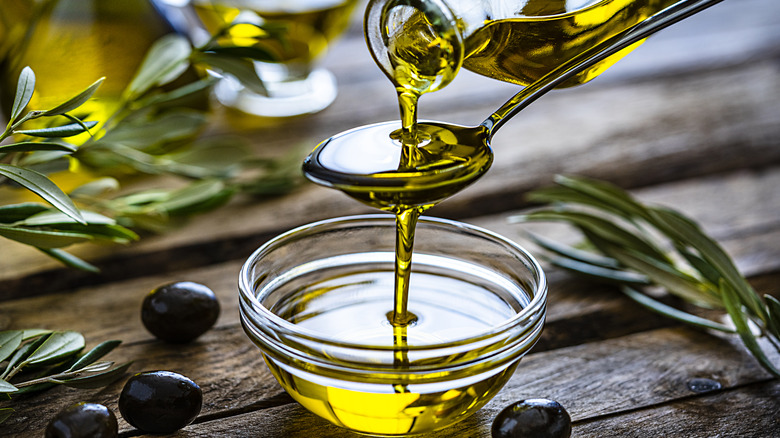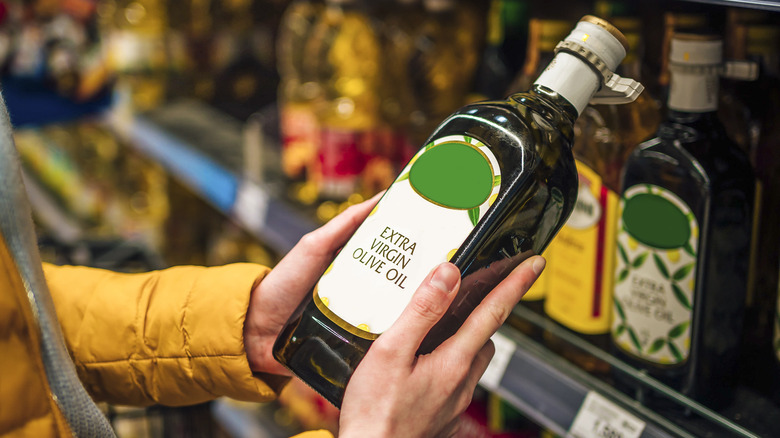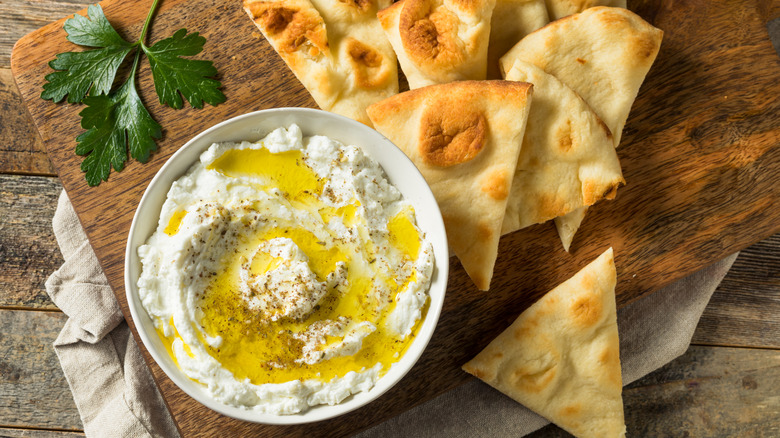What You Should Be Looking Out For When Searching For Real Olive Oil
At the mere mention of extra virgin olive oil, your mind may wander to memories of Rachel Ray drizzling her beloved EVOO into recipes on her classic cooking shows or trips to specialty olive oil shops tasting fragrant, infused varieties of the stuff. Whatever your experience, most cooks and food lovers can agree that extra virgin olive oil — whether it's from Spain, Italy, Greece, or elsewhere — is synonymous with quality.
However, due to the sought-out nature of the flavorful oil (which olive oil maker La Tourangelle explains is made by extracting the juice from olives via cold-pressed squeezing or expeller-pressing with screws), there are, unfortunately, a lot of fraudulent bottles out there claiming to be high-quality extra virgin olive oil, according to the Olive Oil Times. Though it is illegal to adulterate and mislabel food products, culprits of deceiving bottles have been known to mix and dilute extra virgin olive oil with lower grades of olive oil or even with cheap, refined vegetable oils like soybean.
Luckily, with the right olive oil knowledge, you don't have to fear that you're buying less-than-worthy versions. Specifically, the label on your bottle can give you lots of helpful clues to choose a legit olive oil the next time you're walking down the aisle of the grocery store. Olive oil producer Secolari says that while sifting through olive oils you should check the bottles for a third-party certification logo or seal, the date the olives were harvested or pressed, and the location where that occurred.
Trust-worthy olive oil is often certified
At a basic level, the name of different olive oils indicates their specific quality classification. Those labeled "extra virgin olive oil" are the purest, as they have not been refined and pass a regulated set of taste and analytical composition parameters by certifying bodies, such as the International Olive Council (IOC). Lower grades, including "virgin olive oil," may also be unrefined but don't quite reach the high sensory and testing standards (such as an evaluation of their free fatty acid and peroxide composition) required to be "extra."
There are also refined versions simply labeled "olive oil," which use chemical solvents and heat to extract the juice from the olives. Refined oils have a more neutral taste and paler color due to processing, a longer shelf life, and are more suitable for cooking since they've already been treated with heat.
Due to the prevalence of fraudulent olive oils, it helps to look for third-party certifications on the label from organizations like the California Olive Oil Council (COOC) or the Australian Olive Oil Association, which tests the oil for quality and freshness. The North American Olive Oil Association tests various olive oils in the supermarket and marks them with a quality seal based on the IOC's standards. Plus, if you see the harvest date, country of origin, or specific growing estate listed, those are all additional factors that help prove the legitimacy of the oil and its claimed geography.
Put your olive oil to the taste (and appearance) test
While certifying agencies have sensory panels trained to evaluate olive oil for specific quality, taste, and aromatic attributes, you too can learn to tell a quality extra virgin olive oil from lesser-quality (or even disingenuous) bottles. When you take your olive oil home, taste it by pouring a little out on a plate and then drench a hearty slice of bread with the oil. The taste should be a mix of flavors — vividly fruity, earthy, deep, and even peppery — but, most importantly, it should be distinctly flavorful; no bland, nondescript oils allowed.
A true, quality extra virgin olive oil will have a vibrant green tint and should be viscous rather than watery. Any olive oil that is flavorless, yellow or pale, or overly greasy is likely, at the very least, low-quality. Also, look for olive oil packaged in dark glass bottles since, according to Secolari, these best protect the oil from light and heat degradation throughout shipping, on store shelves, and in your pantry.
Once you find a quality extra virgin olive oil that you like, it's time to get dipping. Drizzle the delicious oil over pizza or avocado toast, or blend it into a refreshing pesto made with parsley and toasted pine nuts. Since olive oil's aromatic and flavor qualities deteriorate with heat, it's best to enjoy a quality extra virgin olive oil cold, like when whisked in vinaigrette, rather than to saute veggies in a skillet.


